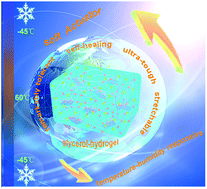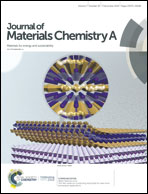A highly stretchable, ultra-tough, remarkably tolerant, and robust self-healing glycerol-hydrogel for a dual-responsive soft actuator†
Abstract
Stimuli-responsive devices based on stretchable, tough, tolerant, and self-healing hydrogels are critical to fabricate soft actuators but it remains a formidable challenge to develop them. Herein, a novel strategy is demonstrated to meet this challenge by incorporating functionalized boron nitride nanosheets (nano-reinforcing domains) into poly(acrylamide-co-maleic anhydride) (soft elastin matrix) hydrogel followed by glycerol–water post-treatment. The resultant glycerol-hydrogel exhibited high stretchability (strain at break up to 2700%), outstanding tensile strength and toughness (up to 2.8 MPa and 19.3 MJ m−3, respectively), long-term dehydration resistance to high temperature (60 °C), and excellent anti-freezing properties at low temperature (−45 °C). Furthermore, excellent self-healing capability was demonstrated by the healing of the hydrogel after three months of storage at temperatures as low as −45 °C. By taking advantage of the outstanding dehydration resistance of the glycerol-hydrogel, dual responsive actuating devices were designed based on bilayer hydrogels to grip, release, and drive a ball under different stimuli. Thus, this work not only inspires the design and fabrication of high-performance hydrogels but also broadens their applications in soft robotics, bioactuators, and other areas.



 Please wait while we load your content...
Please wait while we load your content...